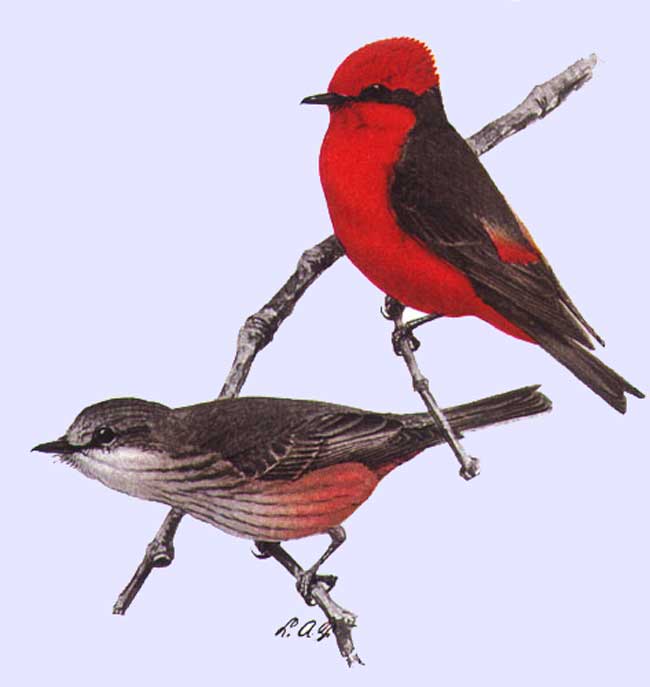
Pyrocephalus rubinus
Superregnum: Eukaryota
Cladus: Unikonta
Cladus: Opisthokonta
Cladus: Holozoa
Regnum: Animalia
Subregnum: Eumetazoa
Cladus: Bilateria
Cladus: Nephrozoa
Superphylum: Deuterostomia
Phylum: Chordata
Subphylum: Vertebrata
Infraphylum: Gnathostomata
Megaclassis: Osteichthyes
Cladus: Sarcopterygii
Cladus: Rhipidistia
Cladus: Tetrapodomorpha
Cladus: Eotetrapodiformes
Cladus: Elpistostegalia
Superclassis: Tetrapoda
Cladus: Reptiliomorpha
Cladus: Amniota
Classis: Reptilia
Cladus: Eureptilia
Cladus: Romeriida
Subclassis: Diapsida
Cladus: Sauria
Infraclassis: Archosauromorpha
Cladus: Crurotarsi
Divisio: Archosauria
Cladus: Avemetatarsalia
Cladus: Ornithodira
Subtaxon: Dinosauromorpha
Cladus: Dinosauriformes
Cladus: Dracohors
Cladus: Dinosauria
Ordo: Saurischia
Cladus: Eusaurischia
Subordo: Theropoda
Cladus: Neotheropoda
Cladus: Averostra
Cladus: Tetanurae
Cladus: Avetheropoda
Cladus: Coelurosauria
Cladus: Tyrannoraptora
Cladus: Maniraptoromorpha
Cladus: Maniraptoriformes
Cladus: Maniraptora
Cladus: Pennaraptora
Cladus: Paraves
Cladus: Eumaniraptora
Cladus: Avialae
Infraclassis: Aves
Cladus: Euavialae
Cladus: Avebrevicauda
Cladus: Pygostylia
Cladus: Ornithothoraces
Cladus: Ornithuromorpha
Cladus: Carinatae
Parvclassis: Neornithes
Cohors: Neognathae
Cladus: Neoaves
Cladus: Telluraves
Cladus: Australaves
Ordo: Passeriformes
Subordo: Tyranni
Infraordo: Tyrannides
Parvordo: Tyrannida
Familia: Tyrannidae
Genus: Pyrocephalus
Species: Pyrocephalus rubinus
Name
Pyrocephalus rubinus (Boddaert, 1783)
Type locality: Tefé, Amazonas, Brazil.
Synonyms
Muscicapa rubinus (protonym)
References
Primary references
Boddaert, P. 1783. Table des planches enluminéez d'histoire naturelle de M. D'Aubenton : avec les denominations de M.M. de Buffon, Brisson, Edwards, Linnaeus et Latham, precedé d'une notice des principaux ouvrages zoologiques enluminés. 58 pp. + table, Utrecht. DOI: 10.5962/bhl.title.39835 Original description p. 42 BHL Reference page.
References
Carmi, O., Witt, C.C., Jaramillo, A. & Dumbacher, J.P. 2016. Phylogeography of the Vermilion Flycatcher species complex: Multiple speciation events, shifts in migratory behavior, and an apparent extinction of a Galápagos-endemic bird species. Molecular Phylogenetics and Evolution 102: 152–173. DOI: 10.1016/j.ympev.2016.05.029 Paywall Reference page.
Vernacular names
čeština: Tyranovec rubínový
dansk: Rubintyran
Deutsch: Rubintyrann
English: Scarlet Flycatcher
español: Mosquero cardenal
suomi: Rubiinityranni
français: Moucherolle vermillon
עברית: ורמיליון
magyar: Rubinfejű tirannusz
italiano: Pigliamosche vermiglio
日本語: ベニタイランチョウ
lietuvių: Raudonasis tironas
latviešu: Sarkanais tirānmušķērājs
Nederlands: Rode Tiran
norsk: Rubintyrann
Diné bizaad: Tsįyaatsiiłchííʼ
polski: Żarek rubinowy
português do Brasil: Principe
português: Verão
русский: Красный тиранн
slovenčina: Pamuchár tmavochrbtý
svenska: Rubintyrann
中文: 朱红霸鹟
The scarlet flycatcher or austral vermilion flycatcher (Pyrocephalus rubinus) is a species of flycatcher, closely related to the vermilion flycatcher. It is found in southeastern Bolivia and Brazil, Paraguay to Argentina and Uruguay. It is recognized as a species by some taxonomic authorities, including the International Ornithologists' Union. Others still consider it to be a subspecies of the vermilion flycatcher.
Taxonomy
The scarlet flycatcher was described by the French polymath Georges-Louis Leclerc, Comte de Buffon in 1779 in his Histoire Naturelle des Oiseaux.[2] The bird was also illustrated in a hand-coloured plate engraved by François-Nicolas Martinet in the Planches Enluminées D'Histoire Naturelle which was produced under the supervision of Edme-Louis Daubenton to accompany Buffon's text.[3] Neither the plate caption nor Buffon's description included a scientific name but in 1783 the Dutch naturalist Pieter Boddaert coined the binomial name Muscicapa rubinus in his catalogue of the Planches Enluminées.[4] The type locality was restricted to Tefé on the Amazon River by the American ornithologist John T. Zimmer in 1941.[5] The scarlet flycatcher is now placed in the genus Pyrocephalus that was introduced in 1839 by the English ornithologist and bird artist John Gould.[6][7] The species is monotypic.[7] The generic name combines the Ancient Greek purrhos meaning "flame-coloured" or "red" and -kephalos meaning "-headed". The specific epithet rubinus is Medieval Latin for "ruby-coloured".[8]
The scarlet flycatcher was formerly considered to be conspecific with the vermilion flycatcher (Pyrocephalus obscurus). The species were split based on a molecular phylogenetic study published in 2016.[7][9]
Description
The scarlet flycatcher appears very similar to the vermilion flycatcher, but can be distinguished by its pointier wings. Their songs are also quite distinctive. Their range and breeding times do not generally overlap with the vermilion flycatcher.[9]
References
BirdLife International. 2017. Pyrocephalus rubinus (amended version of assessment). The IUCN Red List of Threatened Species 2017: e.T103682912A118649386. https://dx.doi.org/10.2305/IUCN.UK.2017-3.RLTS.T103682912A118649386.en. Downloaded on 30 April 2018.
Buffon, Georges-Louis Leclerc de (1779). "Le rubin ou gobe-mouche rouge huppé de la Rivière des Amazones". Histoire Naturelle des Oiseaux (in French). Vol. 8. Paris: De L'Imprimerie Royale. pp. 351–352.
Buffon, Georges-Louis Leclerc de; Martinet, François-Nicolas; Daubenton, Edme-Louis; Daubenton, Louis-Jean-Marie (1765–1783). "Gobe-mouche rouge hupé". Planches Enluminées D'Histoire Naturelle. Vol. 7. Paris: De L'Imprimerie Royale. Plate 675 Fig. 2.
Boddaert, Pieter (1783). Table des planches enluminéez d'histoire naturelle de M. D'Aubenton : avec les denominations de M.M. de Buffon, Brisson, Edwards, Linnaeus et Latham, precedé d'une notice des principaux ouvrages zoologiques enluminés (in French). Utrecht. p. 42, Number 675 Fig. 2.
Zimmer, John Todd (1941). "Studies of Peruvian birds. No. 38, The genera Oreotriccus, Tyrannulus, Acrochordopus, Ornithion, Leptopogon, Mionectes, Pipromorpha, and Pyrocephalus". American Museum Novitates. New York: American Museum Natural History (1126): 16. hdl:2246/4748.
Gould, John (1841). Darwin, Charles (ed.). The Zoology of the Voyage of H.M.S. Beagle, Part III. Birds. London: Smith, Elder and Company. p. 44.
Gill, Frank; Donsker, David, eds. (2019). "Tyrant flycatchers". World Bird List Version 9.2. International Ornithologists' Union. Retrieved 17 August 2019.
Jobling, James A. (2010). The Helm Dictionary of Scientific Bird Names. London: Christopher Helm. pp. 326, 340. ISBN 978-1-4081-2501-4.
Carmi, O.; Witt, C.C.; Jaramillo, A.; Dumbacher, J.P. (2016). "Phylogeography of the Vermilion Flycatcher species complex: Multiple speciation events, shifts in migratory behavior, and an apparent extinction of a Galápagos-endemic bird species". Molecular Phylogenetics and Evolution. 102: 152–173. doi:10.1016/j.ympev.2016.05.029. PMID 27233443.
Retrieved from "http://en.wikipedia.org/"
All text is available under the terms of the GNU Free Documentation License

